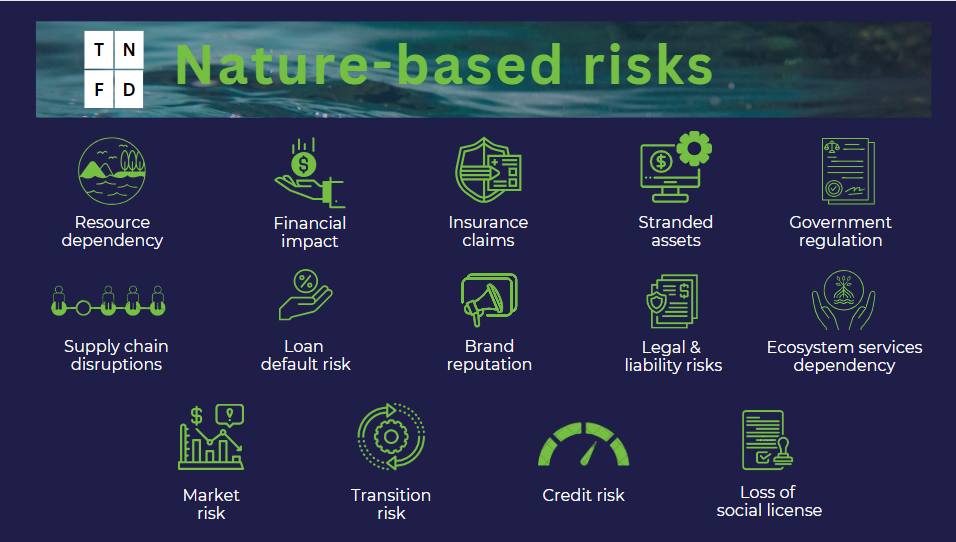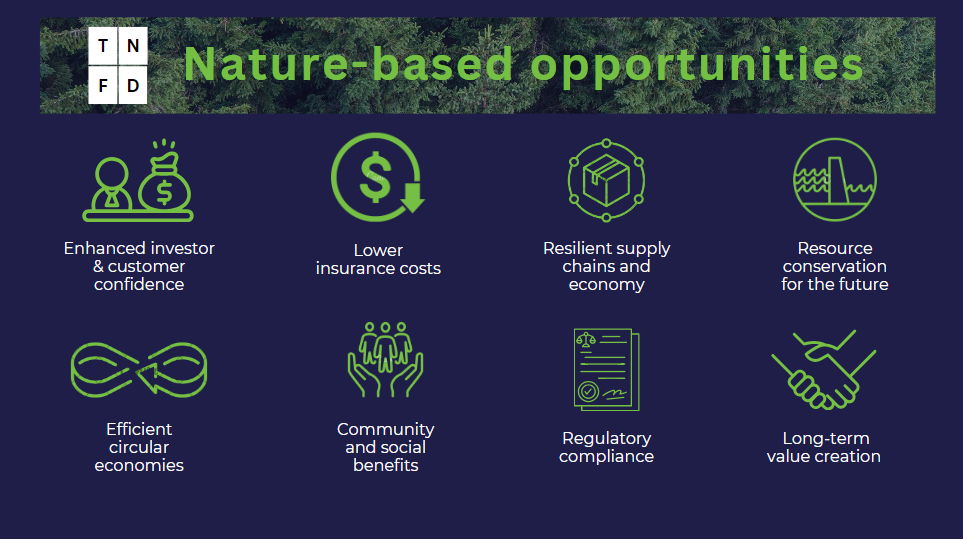Navigating the path to Nature-Related Financial Disclosures
We are running a series of articles on the Taskforce on Nature-Related Financial Disclosures (TNFD). In this first article of the series, we discuss the TNFD framework and explore the nature-related risks and opportunities that may be relevant to financial institutions’ portfolios.
At a Glance
- The Taskforce on Nature-Related Financial Disclosures seeks to bring about a paradigm shift in the way financial institutions assess and manage nature-related risks and opportunities.
- Financial institutions face a wide range of nature-based risks, including resource dependency, financial impacts, insurance claims, government regulation, and more.
- Nature-based opportunities can help financial institutions build investor and customer confidence, reduce insurance costs, strengthen supply chains and economies, among other benefits.
In the ever-evolving landscape of sustainable finance and responsible investing, a new focus framework is set to make waves: the Taskforce on Nature-Related Financial Disclosures (TNFD). This international initiative, building on the success of the Taskforce on Climate-Related Financial Disclosures (TCFD), seeks to usher in a paradigm shift in the way financial institutions assess and address nature-related risks and opportunities.
The launch of TNFD framework has showcased its importance for financial institutions (FIs) to understand its implications and take proactive steps to integrate nature-related considerations into their strategies, operations, and risk management processes.
The TNFD’s mission is clear: to provide a comprehensive framework for organizations to navigate risks associated with negative impact on nature and biodiversity and harness opportunities that may emerge from nature and biodiversity conservation. This initiative recognizes that more than half of the world’s economic output, about US$44 trillion, is moderately or highly dependent on nature. However, there’s a silver lining amidst these challenges. Action toward nature-positive transitions could unlock an annual business value of up to US$10.1 trillion. The TNFD is poised to play a pivotal role in steering capital flows toward these positive actions.
The TNFD framework aims to address the pressing need for organizations to assess and disclose their nature-related risks and opportunities. With a substantial portion of the global economy dependent on nature, understanding and managing these risks is paramount. Nature-related risks encompass a wide array of factors, from loss of biodiversity to degradation of ecosystems. While distinct from climate risk, they are intricately linked, and financial institutions need to consider both as part of their broader risk management strategies.
The TNFD’s approach will consider a wide array of factors, including the loss of biodiversity and ecosystem degradation. Unlike climate risk, nature-related risk assessment is more localized and involves complex, less fungible mitigating activities.
Nature-based risks
A few nature-based risks that may apply to FIs portfolio are as follows:
- Resource Dependency: Businesses rely on natural ecosystems to deliver value. If crucial natural resources face severe stress or vanish, it could harm the company’s long-term prospects. Financial institutions must recognize that the health of the environment directly influences the financial health of businesses.
- Financial Impact: Sustainable investments have surged, with their value quadrupling in a decade. Investors use nonfinancial disclosures, including nature-based risk assessments, for decisions. Financial institutions not attuned to these factors may miss opportunities and face reduced investor interest.
- Insurance Claims: Insurers know the risks tied to environmental damage. Failing to manage these risks, especially the ones linked to nature-based impacts, may be irreversible or catastrophic and lead to higher premiums and larger claims. With climate change amplifying the frequency and severity of natural disasters, insurers are acutely aware of the financial implications and the same apply to nature-based risks. Financial institutions that ignore these risks may find themselves exposed to significant financial losses.
- Stranded Assets: Investments in industries with high nature impact, such as deforestation-linked agriculture, may lead to stranded assets. As global sustainability efforts intensify, these assets may lose value, negatively affecting financial institution portfolios.
- Government Regulation: Governments value biodiversity and are enacting regulations. A company’s swift response to these regulations will affect its risk exposure and costs. Companies that fail to adapt to these evolving regulatory landscapes may face financial penalties and operational constraints. Financial institutions must stay ahead of the curve, ensuring that their portfolios align with emerging environmental regulations.
- Supply Chain Disruptions: Climate change and ecological degradation can disrupt supply chains, leading to delays, increased costs, and reduced reliability. Financial institutions with investments in companies vulnerable to these disruptions may face reduced returns.
- Loan Default Risk: Businesses reliant on natural resources or located in ecologically vulnerable areas face heightened loan default risk as environmental crises, such as droughts or floods, impact their operations. This can result in non-performing loans within financial institution portfolios.
- Brand Reputation: Companies that disregard their environmental responsibilities risk consumer backlash, which can harm their brand reputation and market share. Financial institutions need to consider how their investments may be perceived in this context. Negative public perception can result in loss of trust, affecting customer relationships and attracting regulatory scrutiny.
- Legal and Liability Risks: Companies engaged in unsustainable practices may face legal action and liability claims related to environmental damage. Financial institutions with investments in these companies could be exposed to potential financial losses and reputational damage.
- Credit Risk: The creditworthiness of borrowers can be affected by nature-based risks. Climate events, for example, can harm the financial stability of businesses, leading to credit rating downgrades and impacting the value of debt securities held by financial institutions.
- Market Risk: Nature-related events, such as natural disasters or resource scarcity, can trigger market volatility. Financial institutions may experience fluctuations in the value of assets tied to industries vulnerable to these events.
- Transition Risk: As the global economy shifts towards sustainability, companies that fail to adapt to nature-related challenges may suffer reduced market competitiveness. Financial institutions holding investments in non-adaptive companies may see diminished returns.
- Ecosystem Services Dependency: Businesses often rely on ecosystem services such as pollination, water purification, and climate regulation. The degradation of these services can directly impact the operations and profitability of companies within a financial institution’s portfolio.
- Loss of Social License: With heightened environmental awareness, companies that damage ecosystems or biodiversity may lose their social license to operate. Financial institutions holding investments in such companies, risk backlash from stakeholders, potentially leading to divestment campaigns.

Digital Transformation and ESG: Two peas in a pod

Part I. TNFD for Financial Institutions
Ready for a change in your organisation?
Nature-based opportunities
A few Nature-Based opportunities that may apply to FI portfolios are as follows:
- Enhanced Investor and Customer Confidence: By actively engaging in nature-based financial assessments and aligning their portfolios with sustainable, eco-friendly impacts, financial institutions build trust and confidence among investors and customers.
- Lower Insurance Costs: Financial institutions that invest and lend in businesses with supply chains having least impact on nature are resilient with a reduced exposure to environmental risks. This, in turn, leads to lower insurance premiums, reducing operational costs and enhancing overall financial stability.
- Resilient Supply Chains and Economy: Incorporating nature-based assessments into investment and lending decisions ensures that broader economy become more resilient to nature-related and ecological shocks. Sustainable land management practices and investments in biodiversity conservation can mitigate supply chain disruptions and economic downturns triggered by environmental crises.
- Resource Conservation for the Future: Embracing nature-based financial assessments fosters resource conservation and responsible stewardship across portfolios. Investments in sustainable forestry, fisheries, and agriculture, for example, help secure essential resources for the future while preserving ecosystems and biodiversity.
- Efficient Circular Economies: Financial institutions can play a pivotal role in fostering the transition to circular economies where resources are reused, recycled, and repurposed, reducing impact on nature for more. Circular economy initiatives not only reduce waste and resource depletion but also offer new business opportunities and cost efficiencies.
- Community and Social Benefits: Nature-based financial assessments often result in investments that benefit local communities and societies. Sustainable agricultural projects, renewable energy initiatives, green minerals and nature-based tourism ventures create jobs and stimulate economic growth while promoting social well-being.
- Regulatory Compliance: As governments worldwide increasingly emphasize environmental sustainability, financial institutions that proactively integrate nature-based assessments position themselves favourably with regulators. This compliance not only reduces legal and reputational risks but also opens doors to opportunities within evolving regulatory frameworks.
- Long-Term Value Creation: Nature-based financial assessments focus on the creation of long-term value, rather than short-term gains. Financial institutions that invest in sustainable practices are better positioned to weather economic volatility and market fluctuations, delivering consistent returns to their stakeholders.
Renoir Consulting: Your trusted partners for the TNFD journey
As financial institutions are gearing up to navigate the complexities of nature-related financial disclosures, they recognize the need for a partner being vital in facilitating this transformation. At Renoir Consulting, we pride ourselves on our commitment to excellence and our track record of supporting organizations thrive in an ever-changing business landscape. With TNFD poised to reshape the financial industry’s approach to nature-related risks and opportunities, we are well-prepared to guide you through this transformation. Our consultants bring a deep understanding of global sustainability trends, regulatory landscapes, and best practices. We are dedicated to working alongside your organization, tailoring our solutions to your unique challenges and objectives.
In the next part of this series, which will be published soon, we will look at the impact of TNFD on financial institutions and what financial institutions should be doing to prepare for TNFD. Stay tuned.
Imad Alfadel is the Managing Partner ESG Practice at Renoir Consulting. With over two decades in the financial and consulting sectors, Imad has been supporting companies in enhancing their ESG performance. Through a hands-on approach at Renoir, he supports clients in realizing their ESG ambitions and transforming them into tangible results.
Jagpreet Walia is Partner ESG at Renoir Consulting. As a techno-strategic expert, he has experienced working with clients across emerging and developed markets, leading sustainability, green finance, adaptation, climate risk and decarbonization programs across public and private sectors. His expertise to empower businesses to thrive with collaboration and innovation helps in delivering sustainable impactful results.
Want to unlock nature-related opportunities for a sustainable future?













